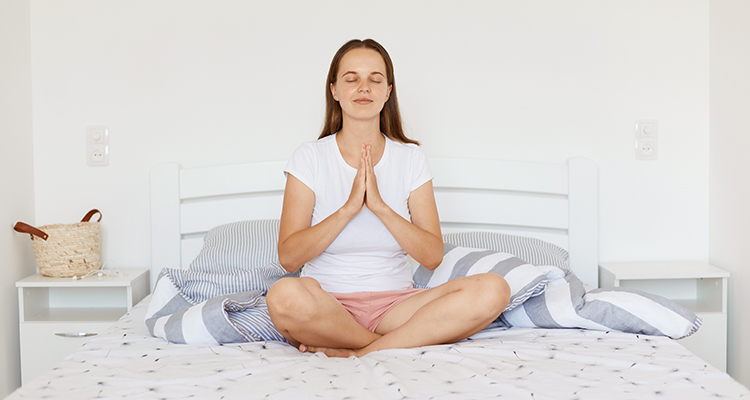Tips and Benefits of a Wind Down Routine Before Bed
Everything you do leading up to bedtime can impact how well you sleep – both positively and negatively. While certain behaviors and routines can sabotage your sleep, others can help you fall asleep faster and stay asleep longer.

As humans, we thrive on routine. Our bodies and minds function better when we follow an outlined group of organized activities. Predictability provides a sense of security and helps reduce stress, promoting relaxation and quality sleep.
But what does a wind-down routine before bed look like and how do you create an effective one? Keep reading for our complete guide to formulating a wind-down routine that fits your unique needs and promotes healthy sleep and productive days.
Content
What is a Wind-Down Routine?
A wind-down, or bedtime, routine is a set of activities or habits that you perform in the same order and around the same time, every night. Most people start their wind-down routine about 60 minutes before laying down. There’s no single wind-down routine that everyone follows. Each set of activities should be unique to your individual needs and preferences. The purpose of a wind-down is to help you relax, destress, and prepare for sleep. Examples of relaxing activities include, but aren’t limited to, meditation, journaling, reading (from a book, not a digital device), taking a warm bath, or listening to soothing music.

The Benefits of Creating a Wind-Down Routine Before Bed
Adults are plagued by approximately 80 different sleep disorders from insomnia to sleep apnea and more. When you’re struggling to fall and stay asleep, both cognitive and behavioral changes can help address whatever underlying symptoms are triggering your sleep troubles. This is one reason why CBT-i (cognitive-behavioral therapy for insomnia) is so popular. It works!
Creating a consistent and beneficial wind-down routine is a form of CBT-i and involves adopting consistent, routine behaviors that you perform, in the same order, before bed every night. By doing so, you’re training your brain and body to relax and prepare for sleep.
Establishing a wind-down or sleep routine offers countless benefits, including:
- Healthy weight
- Clear, focused thinking
- Improved mood
- Reduced stress and anxiety
- Lower risk of serious health problems
- Stronger immune system
When you improve one or more of these conditions, you’ll inadvertently improve your sleep quality.

One of the biggest causes of insomnia is late-night stress and anxiety. Racing thoughts, reviewing the day’s events, or worrying about tomorrow’s “to-do” list can all keep you awake at night. These anxious thoughts activate not only your mind but your body’s sympathetic nervous system. When you create a wind-down routine, your mind is focused on performing these tasks and encouraging yourself to relax instead of mulling over your troubles.
It should come as no surprise that a bedtime routine improves sleep and reduces insomnia symptoms. After all, as children, our parents worked hard to establish a consistent sleep routine and schedule. Doing so often relieved crankiness, helping small children fall asleep faster and wake less frequently. Setting a sleep routine helps children establish a healthy circadian rhythm and learn to calm their nerves. These are healthy sleep habits that carry through into adulthood. Healthy sleep patterns are also attributed to improved memory, better mental health, and increased focus. As adults, these routines help separate the day from night and purge any pent-up stress or negativity.
Remember, winding down for sleep doesn’t happen right away. Your body isn’t a light switch that you can turn from the “on” to the “off” position. It’s a gradual process that you need to ease into. Rushing the wind-down process can leave you feeling “tired but wired”. The behaviors you do or don’t perform at night will directly impact your ability to function the next day, creating an unhealthy cycle of poor sleep and mental fogginess.
Examples of Good Wind-Down Techniques for Adults
Now that you understand the benefits and importance of a wind-down routine for sleep, let’s take a look at some activities you can incorporate into your schedule. Keep in mind that you don’t need to include all of these activities at once, but these examples should give you a good starting point.

Select a Specific Bedtime
When it comes to creating a wind-down routine for bed, timing is everything. That starts with setting your natural circadian rhythm. Choose a specific time to go to bed and wake up each day and stick to it. This includes weekends, holidays, and while on vacation. Following a consistent sleep time schedule helps train your brain to feel tired at night and more alert in the morning. Be sure to start your wind-down routine at the same time every night as well.
Ditch the Digital Devices
We’re all guilty of lying in bed and watching TV, playing video games, or scrolling through social media. While you might think these activities are relaxing, they don’t have a place in your wind-down routine. That’s because electronic devices and screens will actually stop your brain from releasing the sleep hormone melatonin. What you think is helping ease you into sleep is actually keeping you awake!
Stop using all digital devices at least 60 minutes before bed. Keep your phone face down in your bedroom to prevent the screen from lighting up during the night. Don’t sleep with the television on and remove any devices that have a digital or illuminated display like an alarm clock. All of these devices can interfere with your body’s natural progression into “sleep mode”.
Enjoy a Lite Late Night Treat
This wind-down activity ensures that you’re satisfied and full before going to sleep – but not too full! Going to bed on an empty stomach is almost as bad as going to bed after overeating. Eating too much before bed or foods that are heavy or high in saturated fats and sugar can cause discomfort, bloating, acid reflux, and other digestive issues. It may also cause you to wake for frequent bathroom breaks throughout the night.
Instead, opt for a healthy, lite snack like fruit, nuts, oatmeal, or whole wheat toast. All of these food items are high in melatonin, which can help promote sleep. They will also leave you feeling full and satisfied, but not over-full. Another great option is non-caffeinated teas like lavender and chamomile which help ease stress and induce relaxation.
Soothe Yourself with Music or a Warm Bath
Another great nighttime activity before bed is to take a soothing bath or listen to relaxing music – or both at the same time! As your body prepares for sleep, it goes through a slew of hormonal changes. One such change is a drop in body temperature as your brain starts releasing melatonin.One study showed that taking a warm bath mimics the drop in body temperature you experience during sleep. By taking a warm bath before bed, you’re kickstarting your body’s internal wind-down routine. The warm water will help heat your body, and then cool down as the water evaporates, causing you to feel more relaxed and increasingly tired.
Add music to your bath time routine for added relaxation. In fact, 62% of people claim music helps them sleep. While heavy metal might amp you up, the genre doesn’t matter as much as your preference. Choose whatever type of music speaks to you, calms your nerves, and helps distract you from your thoughts and worries. You can also swap music for white or ambient noise like the sound of rain or waves.
Read from a Book or Write in a Journal
Reading is a great wind-down activity before bed. Instead of using a Kindle or tablet, try reading a book or magazine. This way, you can stick to your “no screens before bed” rule. It’s also another childhood practice that carries through into adulthood. Parents often read stories to their children before bed to promote relaxation and inspire peaceful dreams. Enjoy these same benefits by reading drama-free materials. Avoid stories that are too suspenseful or action-packed, as these might excite you before bed. The more boring or dull the material, the better!
Writing in a journal can help purge any negative or anxious thoughts you might have. Let your thoughts flow. Write down anything that’s still on your mind from the day or plans for the next day or upcoming week. Sorting out your thoughts and feelings before bed can stop them from keeping you up at night. If journaling seems overwhelming, start with a simple to-do list to help organize your thoughts.
Exercise Early in the Day
Exercise is a great way to reduce stress, improve your mood, and promote good sleep habits. Remember, the behaviors you perform during the day directly impact how well you sleep. While you shouldn’t engage in high-intensity exercise as part of your wind-down routine, you should incorporate exercise and physical activity into your day. In fact, the earlier in the day, the better. Starting your morning with a vigorous workout helps you feel more alert, focused, and energized. It also helps you to feel more tired at night, making it easier for you to fall asleep and allowing for deeper, more restorative rest.
Practice Meditation or Mindfulness
Meditation and mindfulness are two more activities that promote sleep and can play an important role in your wind-down routine. Though slightly different, both of these techniques help slow down racing thoughts, ease anxiety, and promote relaxation.
Meditation helps you achieve mental clarity while calming your emotions and helping you transition into a more stable, relaxed state. This is achieved by focusing on a single thing while tuning out intrusive thoughts and outside distractions. Mindfulness, on the other hand, encourages you to become fully aware in the moment. During mindfulness, you accept and acknowledge your thoughts as they enter your mind and then release them without judgment. By doing so, you can take away the power and hold they have over you.
Tips for Creating a Personalized Wind-Down Routine
One of the main things to remember when creating your wind-down routine is to customize it to your specific needs and situation. For example, someone on shift work will need to create a different wind-down routine than a new or expecting mother. Listen to your body and what it needs. Not everyone enjoys taking baths or listening to music or you may struggle to quiet your mind during a meditation session. And that’s okay! Set these wind-down techniques aside and choose something that’s more conducive to your lifestyle but still follows the main principles of good sleep hygiene.

Implementing Your Wind-Down Routine Before Bed
Once you decide on what your wind-down routine will look like and include, it’s time to put it into practice. Here are a few more tips for doing just that.
Create a Positive Sleep Environment
Regardless of what you do leading up to bedtime, if your bedroom isn’t conducive for sleep, you might find yourself staring at the ceiling, tossing and turning, or waking up frequently throughout the night. In addition to removing digital devices and screens from your bedroom, you should also block out other intrusive light. Room darkening shades and a sleep mask can help with this.
Invest in comfortable, quality bedding that both supports and cradles your body. Lightweight pajamas can help regulate your body temperature and prevent night sweats. Reduce outside noise by using a sound machine or oscillating fan. Lastly, reserve your bedroom for sleep and sex only. Avoid performing awake activities like eating or working in bed. These activities trick your mind into thinking you should be alert, instead of relaxed.

Structure Your Day Properly
Adopting healthy behaviors leading up to bedtime will help your wind-down routine go more smoothly.
During the Day
Start your day off right by trying a few of these key techniques.
- Get light exposure first thing in the morning to restart your circadian rhythm.
- Drink caffeine in the morning but limit intake in the afternoon.
- If you choose to nap, do so early in the afternoon to prevent disturbing your sleep schedule.
Starting in the Evening
Your evening should consist of two distinct periods of time that will help set the stage for sleep. During your evening peak, which usually occurs around dinner time, try the following activities.
- Exercise if you were unable to do so in the morning, but keep it low-intensity. Try taking a walk or performing yoga.
- Perform a few mentally challenging activities.
- Avoid consuming alcohol or nicotine which can act as stimulants.
Final Wind-Down
Now it’s time to start your official, wind-down routine before bed. Make sure all the activities you perform fall into these categories.
- Limit light exposure from digital devices and other artificial light sources.
- Mentally wind-down by performing stress-reducing activities. Even “mindless entertainment” like reading a book, doing a puzzle, or completing a crossword can slow down your thoughts and promote sleep.
- Reduce your body temperature with a warm bath or by lowering your house’s thermostat to between 60 and 67 degrees.
Create a Flexible but Consistent Wind-Down Routine
The best wind-down routines are equal parts flexible and consistent. If the initial routine and techniques you adopt aren’t working, don’t be afraid to make adjustments. With that being said, give your body at least 7 days to adjust to your new routine. If after that, your sleep doesn’t improve, make minor changes.

In addition to the suggestions above, therapy and certain types of insomnia treatment can support your efforts. Let Somnus Therapy help you accept, understand, and overcome your sleep troubles through our convenient, at-home approach to insomnia treatment.














